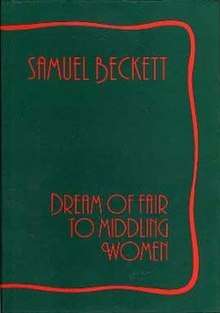Dream of Fair to Middling Women
Dream of Fair to Middling Women is Samuel Beckett’s first novel. Written in English "in a matter of weeks" in 1932 when Beckett was only 26 and living in Paris, the clearly autobiographical novel was rejected by publishers and shelved by the author. The novel was eventually published in 1992, three years after the author's death.
 First edition | |
| Author | Samuel Beckett |
|---|---|
| Country | United States |
| Language | English |
| Publisher | Black Cat |
Publication date | 1992 (written in 1932) |
| Media type | Print (Hardcover & Paperback) |
| Pages | 241 pp |
| ISBN | 978-0-948050-09-1 |
| OCLC | 27052646 |
Partial publication
Three fragments from the book were published during Beckett's lifetime: "Text" and "Sedendo et Quiescendo" were actually published before he started working on the book and subsequently became part of it, whilst "Jem Higgins' Love-Letter to the Alba" was published in 1965. Beckett refused however to allow the entire novel to be published during his lifetime, on the grounds that it was "immature and unworthy": his biographer Deirdre Bair believes that his reluctance to make it available to the reading public was to avoid offending lifelong friends whom Beckett satirised in the book.[1]
Setting and influences
The novel is set in the town of Kassel, Germany, where 17-year-old Peggy Sinclair, a cousin of Beckett, lived with her parents. Beckett made several visits in Kassel 1928–32. The main character Belacqua, a writer and teacher, is very similar to Beckett himself, though a character named "Mr. Beckett" also makes an appearance in the book. Belacqua's name is taken from the character created by Dante. Influences on the novel include Geoffrey Chaucer's The Legend of Good Women, Alfred Tennyson's "A Dream of Fair Women" and Henry Williamson's The Dream of Fair Women.[1]
Themes
Two main themes can be found in the Dream: a rejection of realism in characters and the novel itself;[2] and an anti-feminism,[3] or perhaps an anti-sexuality, disavowing the possibility of sexual relations. The narrator explicitly criticises such realist figures as Balzac and Jane Austen, for their rigid characters and spurious novelistic coherence;[4] but also challenges Proust’s exploitation of involuntary memory, and his metaphoric method of approach.[5]
At the same time, the work is concerned with a sense of the body as a machine that is broken;[6] and with male sexuality as oscillating between Apollo and Narcissus. “We give you one term of Apollo: chasing a bitch, the usual bitch. And one term of Narcissus: running away from one”.[7]
Both themes come together in a rejection both of a realist world, and of a unified self to be found in sexual relations.[8]
See also
- More Pricks than Kicks
- Proust (Beckett essay)
References
- Acheson, James (1988). Samuel Beckett's early fiction and drama: A study of artistic theory and practice (PDF) (Ph.D.). University of Canterbury. pp. 34–35. Retrieved 5 December 2016.
- P Stewart, Zone of Evaporation (2006) p. 41-2
- K Ince ed., Samuel Beckett (London 2000) p. 74
- P Stewart, Zone of Evaporation (2006) p. 41 and p. 60
- P Stewart, Zone of Evaporation (2006) p. 21 and 42
- Y Tajiri, Samuel Beckett and the Prosthetic Body (2006) p. 5
- Dream, quoted in K Ince ed., Samuel Beckett (London 2000) p. 196
- K Ince ed., Samuel Beckett (London 2000) p. 73-4
External links
- (in German) Beckett´s visits in Kassel,Germany, incl. picture of Peggy Sinclair
- Autobiographical aspects